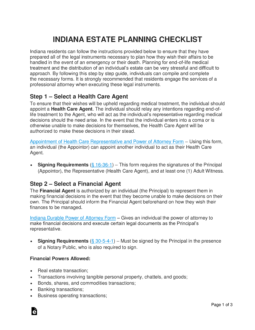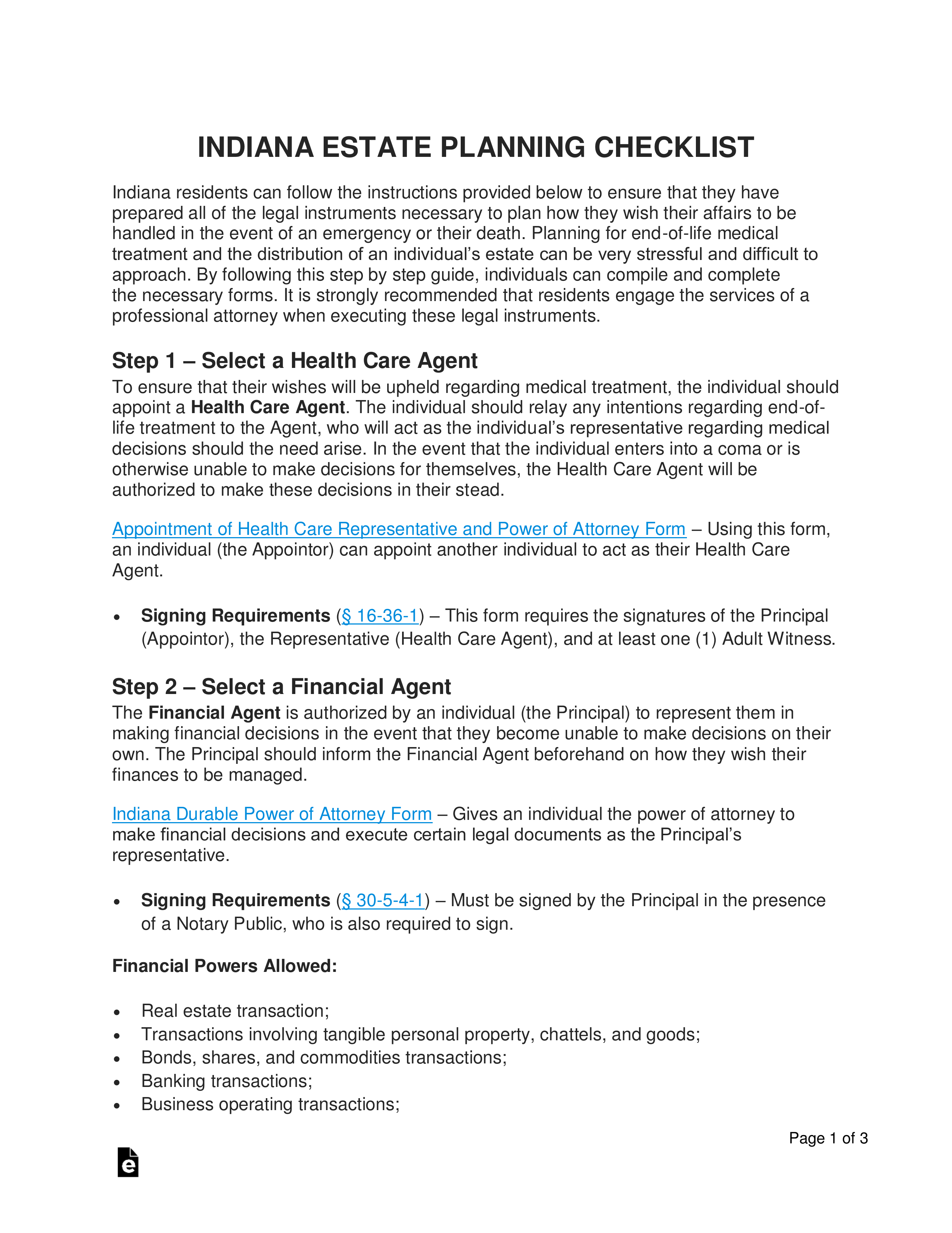Updated March 05, 2024
An Indiana estate planning checklist is a document that can be referred to by residents when organizing their plans for end-of-life medical treatment, management of their finances, and administration of their estate when they die. A Last Will and Testament and/or Revocable Living Trust are essential to ensuring that an individual’s personal property and assets are distributed according to their wishes. To prepare for medical emergencies, possible mental incapacity, or other extenuating circumstance individuals should appoint a health care agent and financial agent by completing the Appointment of Health Care Representative and Power of Attorney and Durable Power of Attorney forms.
How to Create an Estate Plan in Indiana (6 steps)
- Select a Health Care Agent
- Select a Financial Agent
- Make a List of All Estate Items
- Select Beneficiaries
- Decide How to Transfer the Estate
- Keep the Documents Safe
Indiana residents can follow the instructions provided below to ensure that they have prepared all of the legal instruments necessary to plan how they wish their affairs to be handled in the event of an emergency or their death. Planning for end-of-life medical treatment and the distribution of an individual’s estate can be very stressful and difficult to approach. By following this step by step guide, individuals can compile and complete the necessary forms. It is strongly recommended that residents engage the services of a professional attorney when executing these legal instruments.
1. Select a Health Care Agent
To ensure that their wishes will be upheld regarding medical treatment, the individual should appoint a Health Care Agent. The individual should relay any intentions regarding end-of-life treatment to the Agent, who will act as the individual’s representative regarding medical decisions should the need arise. In the event that the individual enters into a coma or is otherwise unable to make decisions for themselves, the Health Care Agent will be authorized to make these decisions in their stead.
Appointment of Health Care Representative and Power of Attorney Form – Using this form, an individual (the Appointor) can appoint another individual to act as their Health Care Agent.
- Signing Requirements – This form requires the signatures of the Principal (Appointor), the Representative (Health Care Agent), and at least one (1) Adult Witness.[1]
2. Select a Financial Agent
The Financial Agent is authorized by an individual (the Principal) to represent them in making financial decisions in the event that they become unable to make decisions on their own. The Principal should inform the Financial Agent beforehand on how they wish their finances to be managed.
Indiana Durable Power of Attorney Form – Gives an individual the power of attorney to make financial decisions and execute certain legal documents as the Principal’s representative.
- Signing Requirements – Must be signed by the Principal in the presence of a Notary Public, who is also required to sign.[2]
Financial Powers Allowed:
- Real estate transaction;
- Transactions involving tangible personal property, chattels, and goods;
- Bonds, shares, and commodities transactions;
- Banking transactions;
- Business operating transactions;
- Insurance transactions;
- Estate transactions;
- Gift transactions;
- Claims and litigation;
- Personal relationships and affairs;
- Benefits from government programs and military service;
- Records, reports, and statements;
- Delegation;
- Voter registration and absentee ballot requests; and
- and other requests as allowed within the State by the Principal.
3. Make a List of All Estate Items
4. Select Beneficiaries
5. Decide How to Transfer the Estate
Now that the individual has made a list of their current assets and decided who their beneficiaries will be, they will need to execute a legal instrument that ensures that their estate will be distributed in accordance with their wishes. There are two main (2) types of instruments that an individual can use to distribute their estate.
Last Will and Testament – Individuals can use this legal instrument to leave instructions on how their property should be administered when they die.
- Signing Requirements – Required to be signed with at least two (2) witnesses present.[3]
Revocable Living Trust – A Living Trust allows an individual to put their assets into a Trust; all assets in the Trust will bypass probate when they are distributed after the individual’s death.
6. Keep the Documents Safe
Indiana Estate Planning Laws
- Advance Health Care Directive – § 16-36-1
- Durable Power of Attorney – § 30-5-4-2
- Last Will and Testament – § 29-1-6-1
- Living Trust (Revocable) – § 30-4-2-1.5


